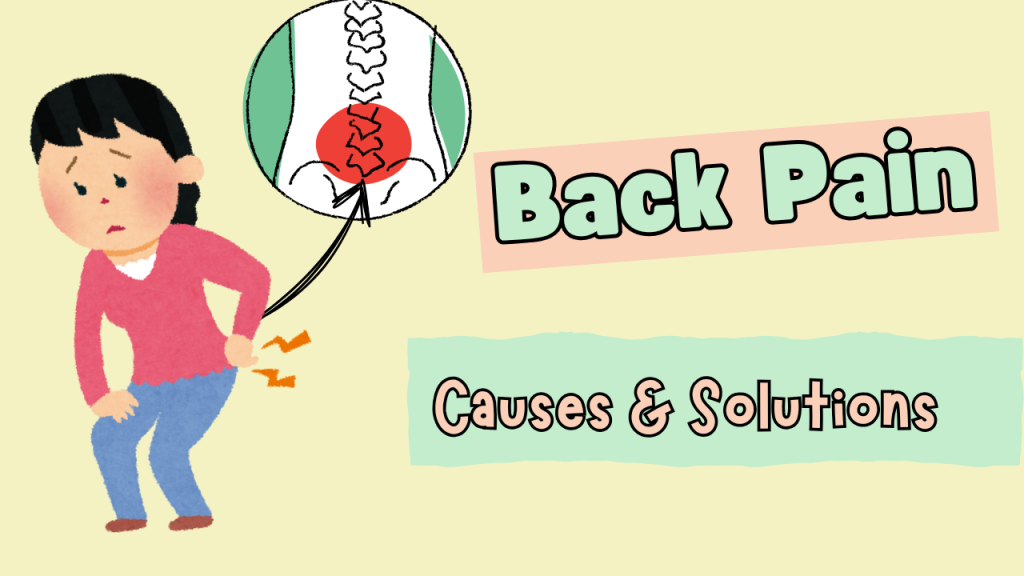Introduction
Back pain is a major reason for our productivity going down. It has become a part of many women’s lives, and our lifestyle affects it, and vice versa.
Not one. There are many reasons why back pain is especially common in women due to lifestyle and physical factors. From dawn to dusk, we work as a machine, paying little attention to how we sit and what we eat. Every single accessory affects our body. Also, we can’t ignore stress, the major culprit for every psychosomatic disorder, and we have no idea about it.
The reason I am writing this blog is to let you know and understand the reasons behind your back pain. I am also going to share the possible ways to cure and control it. Hey, I suffer from it, I know how painful it is, so just trust me and keep on reading.
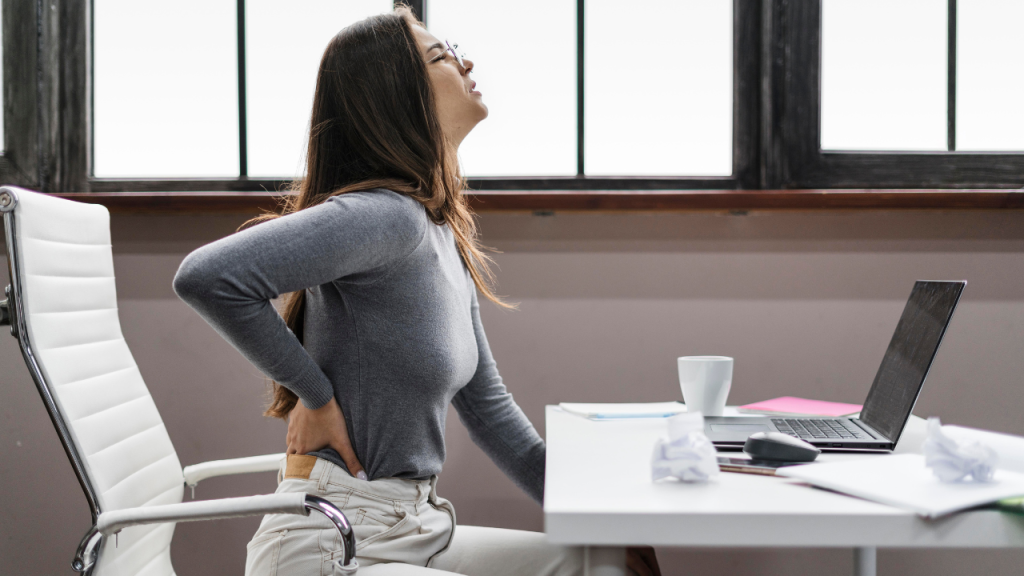
Table of Contents
Common Causes of Back Pain Among Women
There are several reasons why we experience back pain when we wake up in the morning and hit the sack at night. Find out which is the one you relate to:
Hormonal Changes
Periods, pregnancy, and menopause fluctuate hormones. It is common to experience back pain during any of these phases.
Menstrual Cycles: Lower back aches during your period are common and can be an uncomfortable part of the monthly cycle for many women.
Pregnancy: Back pain is a part of the pregnancy journey. There is extra weight, shifts in posture, and soft joints that help prepare for delivery. There is no surprise our backs feel the strain!
Menopause: During menopause the estrogen levels drop, and back pain can start to creep in, sometimes making this stage even harder. Hormonal shifts can lead to less muscle, and it leads to weak support around the spine.
Why Do These Hormonal Changes Matter for Your Back?
Drop in Estrogen: During menopause, when estrogen dips, it’s not just hormones we feel – our backs can feel it too!
Loss of Muscle Mass: With less estrogen, we tend to lose muscle, including those core muscles that support the back. It’s like losing some of the natural support our bodies rely on.
Worsening Arthritis: As estrogen decreases, arthritis symptoms can worsen, adding to joint pain and swelling. It’s no wonder the back feels it too!
Back Injury
There are many reasons why your back gets injured. Check if you have experienced any of these.
Strained Muscles or Tendons: Lifting something the wrong way or making a sudden, awkward move can strain your back muscles or tendons, leaving you sore and uncomfortable.
Sprained Ligaments: Twisting too much or lifting without thinking can sprain the ligaments in your back. This type of pain can make it tough to move!
Herniated or Ruptured Disc: If a disc in your spine gets squeezed too hard, it can press on nearby nerves, causing pain that can stick around.
Spinal Canal Narrowing: When the spaces in your spine narrow (called spinal stenosis), it can press on nerves, often due to arthritis or other changes in the spine.
Bones Fusing in the Spine: A condition called ankylosing spondylitis causes bones in the spine to fuse, leading to stiffness and pain.
Broken Vertebrae: Osteoporosis, a condition that makes bones fragile, can sometimes lead to fractures in the spine, causing sharp back pain.
Poor Posture
We get that camel’s hump and we realize we are not comfortable, our neck creating constant trouble. It is all because of a poor posture. What else is in it.
Muscle Strain and Imbalance: Our back muscles don’t work evenly when we don’t sit or stand straight. Some muscles end up working way harder than others, which can make them feel tight, tired, and achy.
Too Much Pressure on Joints: Bad posture puts uneven pressure on the joints in our spine. Over time, this can make the joints sore and even cause long-term wear.
Disc Compression: Slouching or hunching over can squish the discs in our spine. When they get too compressed, it can lead to issues like herniated discs or pinched nerves – both of which can be pretty painful.
Reduced Blood Flow: Poor posture can even mess with blood flow to the spine. When blood doesn’t flow properly, it’s harder for the spine to heal and stay healthy.
Brain’s Response: Believe it or not, bad posture can also trick your brain into thinking your body needs extra support. This causes even more muscles to tighten, which just adds to the discomfort.
Common Postures That Cause Back Pain: Some postures that can lead to back pain include – slouching, a rounded back, sway-back, a flat back, or scoliosis (curved spine).
Weak Core Muscles
There is a connection between our core and back muscles. We take care of our core muscles, it takes care of our back. But what happens when our core isn’t strong?
Overworking Other Muscles: When your core muscles are weak, other muscles in your body have to step in and work extra hard to keep your spine steady. This can lead to back pain since those muscles aren’t meant to take on all that work alone!
Poor Posture: A weak core makes it hard to sit or stand up straight, often leading to slouching. Slouching puts strain on your back muscles, joints, and even the discs in your spine, making your back feel sore and achy.
Higher Risk of Injury: Without a strong core, even simple movements can make you more likely to get hurt. It’s like your back isn’t fully protected and can get strained easily.
Spine Compression: When core muscles are weak, the spine lacks support and may become compressed. This can lead to pinched nerves, herniated discs, and other painful spinal issues.
Heavy Bags
A bag is an essential part of women’s daily look and life. So a bag is a must-have. But if it is too heavy, it is too dangerous sometimes.
Strains Muscle: Carrying a heavy bag on just one shoulder puts a lot of pressure on your neck, upper back, and shoulder. Since the weight isn’t balanced, you end up holding one shoulder higher than the other, which strains those muscles and can make them sore.
Leads to Poor Posture: To balance the weight of a heavy bag, you might start leaning forward, which causes your shoulders to slump and your spine to curve. This poor posture can lead to more back pain over time.
Changes the Way You Walk: Carrying a heavy bag can change the natural way your arms and legs move while you walk, making your whole body feel out of balance.
Can Lead to Long-Term Pain: Carrying a heavy bag regularly can add up, causing serious back pain or even muscle spasms and pinched nerves in the long run.
Common Back Injuries from Heavy Bags: Some back problems that can come from lifting heavy bags include strained back muscles, bulging or herniated discs, and even spinal fractures.
High Heels and Wrong Footwear
We all love to wear heels. I feel like I’ll start a ramp walk the moment I put on my high heels on. But the fact is, these could lead to some serious health issues in the long run. Wearing High Heels or the Wrong Shoes Can Cause Back Pain as it
Makes Your Lower Back Arch More: High heels make your pelvis tilt forward, which causes your lower back to arch more than usual. This kind of extra curve can lead to tension and soreness in muscles.
Tightens Muscles from Foot to Back: When you wear high heels, they pull on the ligament that supports your foot’s arch. This can make the muscles up your legs and back tighten up, putting strain on your lower back.
Shifts Your Balance Forward: Walking on the balls of your feet pushes your balance forward, so you might feel the need to arch your back more just to stand up straight.
Pushes Parts of Your Spine Forward: High heels can throw off your spine’s alignment, especially in your upper back and neck. This makes your shoulders lean forward and can lead to a hunched posture over time.
Throws Off Your Balance: High heels can mess with your balance, making it harder for your core muscles to keep you steady.
Tip: To avoid back pain, look for shoes that fit well, offer cushioning, and give your feet good support!
Stress and Mental Health
Stress can cause back pain in women in several ways, including
Muscle Tension: When you’re stressed, your body releases hormones to prepare you for “fight or flight.” This makes your muscles tense up, especially in your back, shoulders, arms, and legs, which can lead to that achy feeling.
Poor Posture: Ever notice how you start to hunch or raise your shoulders when you’re stressed? This can strain your upper and middle back, adding to your discomfort.
Reduced Blood Flow: Stress can cause your blood vessels to tighten, which reduces blood flow to your muscles. Less blood flow means your back muscles don’t get the oxygen they need, leading to soreness.
Increased Sensitivity to Pain: When you’re stressed, your body can become more sensitive to pain, so even small aches might feel worse than usual.
Inflammation: Chronic stress can cause inflammation throughout the body, including your back, which can make pain last longer.
Effective Solutions for Back Pain
Heat and Cold Therapy
Back muscles are sore when it pains. A good heat and/or cold therapy can be a big help. Experts can recommend a suitable one. Generally, when there is muscle swelling, cold therapy is used, especially when it is just the beginning of the pain. But when the pain is chronic, heat therapy is used as it reduces the muscle spasms and increases the flow of nutrients.
Posture Correction Tips
These tips are all about how you stand, sit, and work. We need to keep the spine in its natural form, avoiding hunching of the back. It’ll avoid any strain on the lower back. A simple trick is to pretend as if we are standing against the wall. Stand tall, head level, and weight on the balls of the feet. Similarly while sitting, a good posture can reduce the load on the discs of our lower spine. If you must sit for longer periods, remember to take breaks and walk. Avoid being in one position for too long, whether you stand, sit, or lie.
Core Strengthening Exercises
Core muscles give support to the spine. Strong core muscles reduce back pain by improving our balance, posture, and coordination. There are certain core strengthening exercises that every woman should do:
Plank
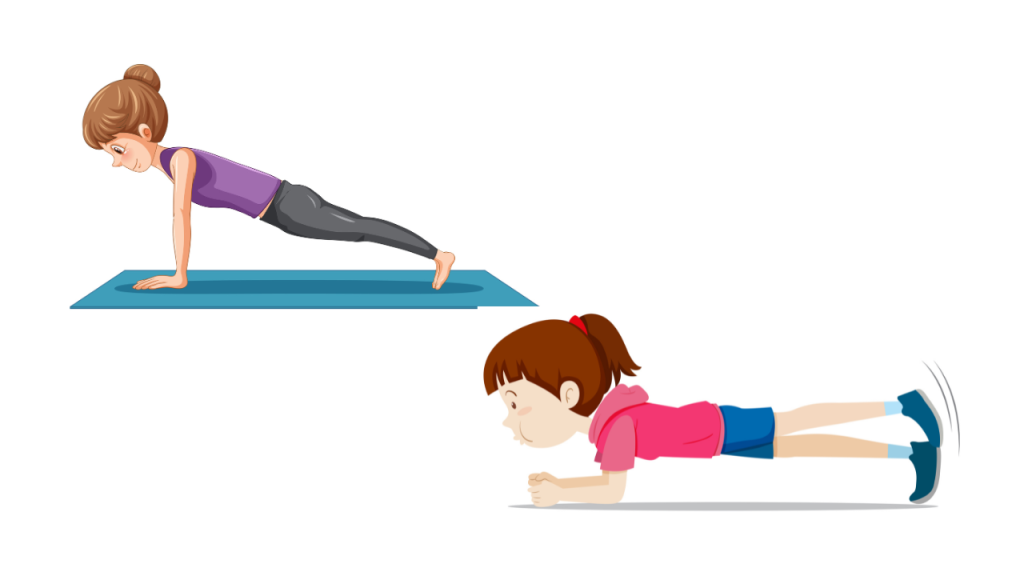
Cat-Cow Pose
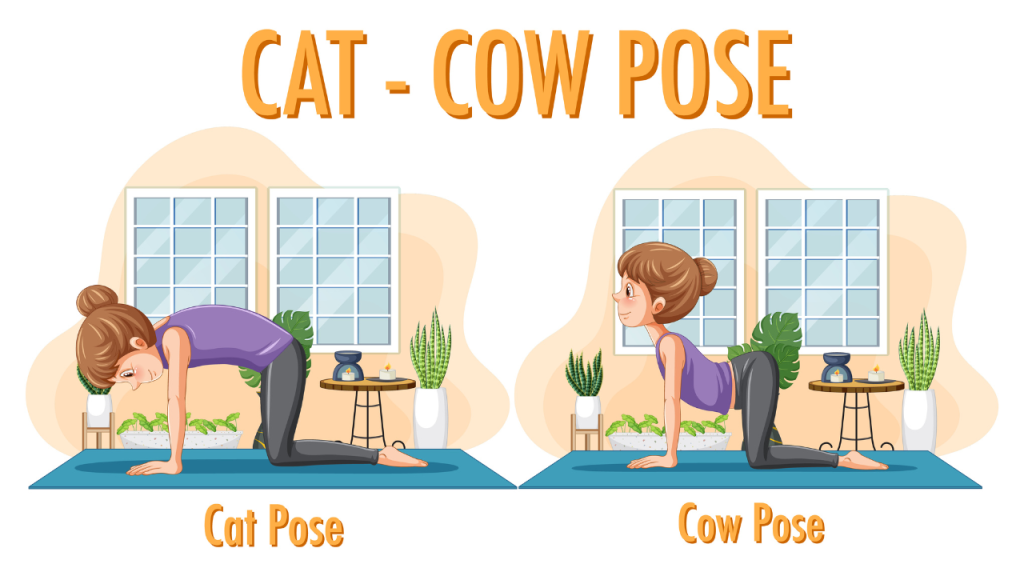
Bridge Pose
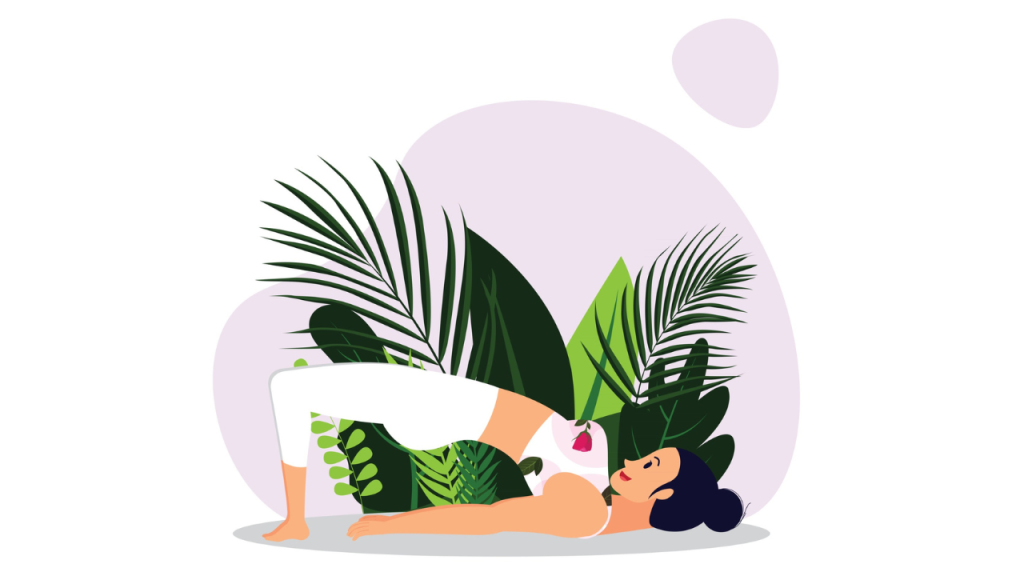
There are many other poses that can help in reducing back pain. You can watch this video and practice along.
Stretching Routine
Regular stretching can make the back muscles flexible. Daily practice will avoid injury from any sudden jerk. Here are some videos that show the stretching for the back.
Footwear Recommendations
Heels for longer periods can be avoided. If possible, prefer flat footwear. And the quality of the matters. To avoid back pain, look for shoes that fit well, are cushioned, and provide support.
Mindfulness and Relaxation Techniques
It’s important to control psychosomatic disorders and for that, control stress. Practice mindfulness, deep breathing, and relaxation techniques daily for a minimum of 5-10 minutes. A simple “OM” chant can do wonders.
Taking Rest and Sleep Well
Our body needs rest. When we have backaches, it is even important to take frequent rest to help our back muscles relax and recover from the fatigue, tension, and stiffness. This practice ensures we aren’t overburdening the back muscles. Also, a night of proper sleep is essential for the body to heal and repair. It reduces inflammation and improves pain tolerance.
Visit the Doctor when nothing works
At last, when nothing works, it is better to see a doctor. An expert can surely help you in this regard. Through various tests and diagnoses, he/she can suggest medicine, treatments, and therapies to help you with your back pain.
Lifestyle Tips for Long-Term Relief
Balanced Diet
A plate full of a variety of colorful food items such as nuts, vegetables, fruits, etc. can help with inflammation and improve muscle and bone health. Different food items ensure a supply of macro and micro-nutrients that are essential for the overall well-being of the human body. Bone health, reduced inflammation, and weight management are some of the benefits of a balanced diet.
Regular Physical Activity
Regular physical exercises strengthen the muscles, improve the flexibility of the butt, legs, and back, increase blood flow, and relieves muscle spasms. There are many activities like yoga, stretching, aerobics, etc. to move our body.
Avoiding Heavy Lifting
Heavy lifting can strain and tear the muscles which can be very painful. It can further lead to back stiffness and tightness. So be mindful while lifting heavy weights. If you want to build strength, you can gradually add more resistance to your lifting. You should start with a weight you can comfortably lift and progress slowly and steadily.
Self-care Practices
All the practices discussed above are included in self-care practices. Listening to your body and then acting accordingly is important. It ensures a healthy and safe body.
Conclusion
Back pain is a major problem in women and it is very important to address it with utmost care. There are several reasons why we experience back pain, which include our posture, muscle weakness, hormonal fluctuations, stress, etc. By finding out possible reasons, we can take necessary actions to ensure a healthy and productive day ahead.
By making small changes in our lifestyle like proper posture, diet, stress management, and exercises, we can find a way to deal with the situation without affecting our confidence.
I hope you find this a valuable piece. I would love to know your thoughts on it, or maybe you have something to share with us. Feel free to leave your kind comments and keep on reading more valuable content here.

